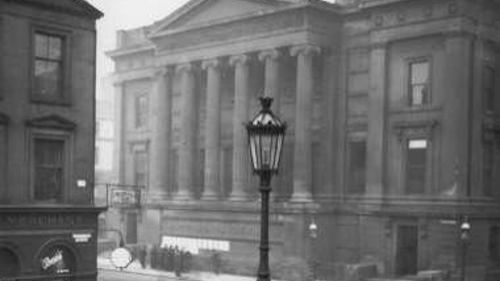Early Municipal Buildings - Times Past

In partnership with the Glasgow Times, our archivists are exploring Glasgow's fascinating history. This week, Dr Irene O'Brien writes about early municipal buildings.
The history of Glasgow’s municipal public buildings tells the remarkable story of the growth of the population and the scale of the work undertaken by an interventionist Council on their behalf.
The earliest home of the Council for which we have definite knowledge was the 17th century Tolbooth, which took the place of an older Tolbooth which dated from at least 1454. In 1625 the old Tollbooth was ruinous, and arrangements were made to have it replaced in 1626. So disappeared the earlier Tolbooth or Council-house of Glasgow which was replaced by a more modern structure on the same site.
The new Tolbooth was completed in September 1627. It was a very handsome picturesque building, in the Scots French manner of the period, four storeys high over a basement. The top level was reached by an external double staircase. Only the steeple now remains.
Although it served for almost two hundred years, at an earlier stage it was realised that the Tolbooth was too small to host Council meetings. In the 1730s the Council bought adjoining land on the west side for a new council chamber, municipal offices, and assembly rooms. It had an internal link to the Tolbooth. Completed in 1740, it was surrounded by a piazza, under which after 1801, shops were placed. The Town Hall was used for all important public and municipal functions and festivities, and when its public functions ceased in 1854, it closed with a banquet for the inauguration of the equestrian statue of Queen Victoria.
During the 19th century the Council Chambers moved four times as their accommodation failed to meet its rapidly increasing requirements for new council chambers. In 1807 the inadequacy of the Tolbooth buildings was officially recognised by the Council. In 1809 the Council agreed to erect a new building to include a new Jail, Court Hall, and Council Chambers. The Justiciary Courts were designed by William Stark and erected at the foot of Saltmarket 1809-1814.
The growing city was not long in outstripping the accommodation of the building at the Green. In 1844 a new building was erected in Wilson Street to accommodate the municipal administration of the city and the judicial work of both the City and Counties. This too was short-lived, and the Council acquired the rest of the block between Wilson and Ingram Streets, and the municipal offices moved to Ingram Street end of the block.
Ingram Street was never going to be a long-term solution and from the first day, was seen as a temporary makeshift. The city had continued to expand and had acquired extra functions including police, parks, galleries, museums, and water supply. A huge Health Department had been organised, and they had begun the construction of the Tramways offices. In 1878 they obtained powers to acquire the two blocks on George Square. The rest is history.
